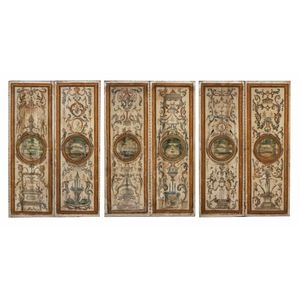The Régence style of French furniture emerged during the early 18th century, spanning roughly from 1715 to 1730. This transitional style bridged the gap between the preceding Louis XIV style and the subsequent Rococo style of Louis XV, incorporating elements of both while also introducing new design characteristics.
The Régence style is characterized by its lighter and more fluid forms compared to the robust and heavy furniture of the Louis XIV era. It exhibits a sense of grace, refinement, and a departure from the strict symmetry that defined the earlier style. The design elements of the Régence style were influenced
more...
by a growing interest in the decorative arts, Oriental influences, and a desire for more intimate and comfortable interiors.
Chairs in the Régence style often feature curved backs and cabriole legs, which are elegantly carved and terminate in scrolled feet. The seats are padded and typically upholstered with rich fabrics, such as silk or velvet. The backs of the chairs may showcase intricate carving or openwork, often depicting foliage or shell motifs. The armrests are gracefully shaped and sometimes adorned with acanthus leaf motifs.
Tables in the Régence style can vary in shape, including rectangular, round, or oval forms. They often feature slender, curvaceous legs, sometimes with carved decorations such as scrolls or acanthus leaves. The tabletops may be adorned with marquetry or parquetry, showcasing intricate patterns or scenes. Exotic woods, such as rosewood or kingwood, were commonly used in the construction of Régence furniture.
Chests of drawers and commodes in the Régence style often have curved or serpentine fronts, imparting a sense of movement and elegance. They feature delicate and finely executed carving, with motifs such as acanthus leaves, flowers, or shell designs. The hardware, including drawer pulls and escutcheons, is typically ornamental and may incorporate motifs such as foliage or mythical creatures.
Mirrors in the Régence style are typically tall and narrow, with elegant and sinuous frames. The frames may be adorned with carved decorations, such as scrolls, shells, or foliage motifs. The mirrors themselves are often divided into sections, creating an interesting visual effect.
The Régence style incorporates a light and playful color palette. Soft pastel shades, such as pale blues, pinks, greens, and creams, are commonly used in upholstery and decorative elements. Gilding is also prevalent in Régence furniture, adding a touch of luxury and enhancing the overall elegance of the pieces.
The Régence style represents a transitional period in French furniture design, blending elements of the preceding Louis XIV style with the emerging Rococo aesthetic. Its graceful curves, refined carving, and lighter forms reflect a shift towards more intimate and comfortable interiors. The Régence style continues to be appreciated for its elegance, charm, and its influence on the subsequent development of French furniture design.
less...
The glass-fronted bookcase entered the English cabinetmakers' repertoire about the mid-17th century, and the bookcase in one form or another has been an indispensable part of the civilized person's home ever since.The 17th century bookcase tended to be a glazed cabinet from plinth to pediment, with square glass panes. The later Stuart period saw the introduction of the bureau bookcase or the secretaire bookcase, where the bookshelves were double-heightened above a desk or cupboard base. Early bureau bookcases often had mirror or blind-panelled door fronts, although these have frequently been replaced with clear glass
more...
panes. During the Regency period, the fashion arose for small cabinet bookcases, rarely more than three feet in height, which left the walls clear for hanging prints and pictures, known in the trade as a 'dwarf bookcase'. Such bookcases were sometimes open at the front, others had elegant brass-grille doors, backed by pleated silk. A bookcase without doors is known in the trade as an 'open bookcase'. The revolving bookcase was invented during the 18th century. Small enough to stand on the floor beside a chair, it was an ideal companion for the bookworm, and is still being made. A large number of these were made from the 1930s to the 1950s for sale with a complete set of the Encyclopedia Britannica. However in the market place revolving bookcases are scarce.In Australia bookcases tended to follow the fashionable British designs. The finest examples were made in cedar, sometimes veneered with rarer native species. Others, towards the later part of the colonial period, were made of pine, frequently stained or varnished, and featuring the typical Edwardian machine carvings in the pediments and lower door panels.
less...


 Loading more...
Loading more...